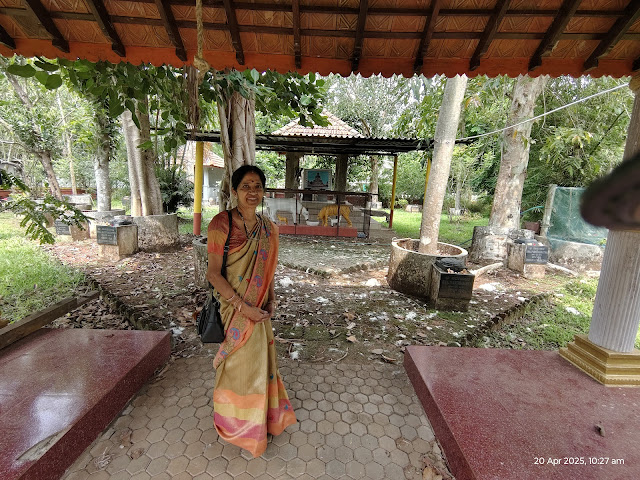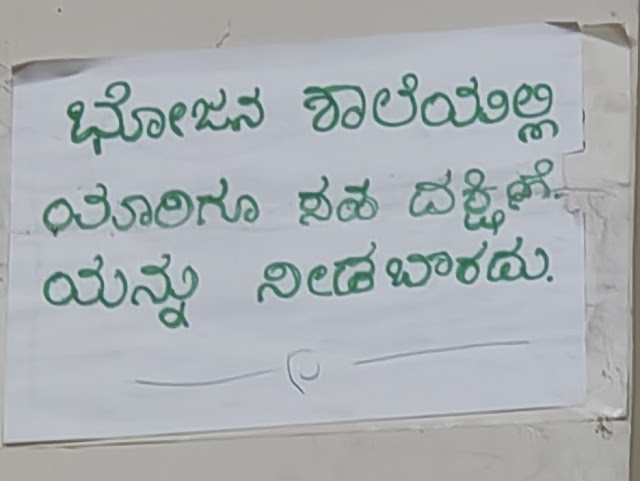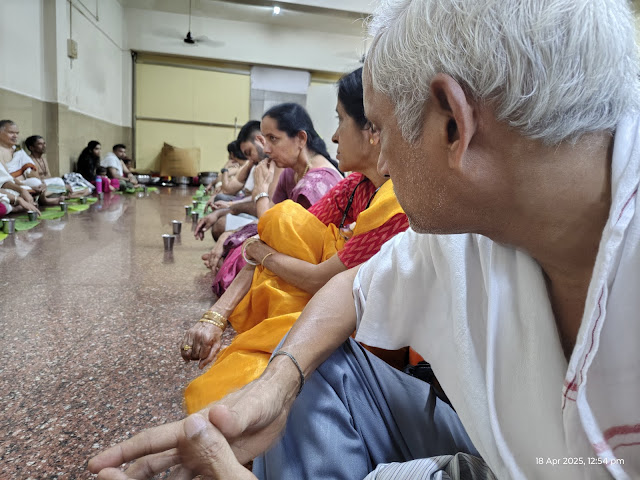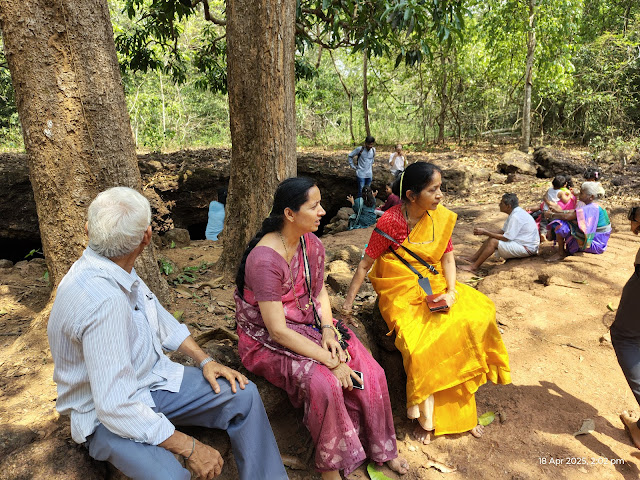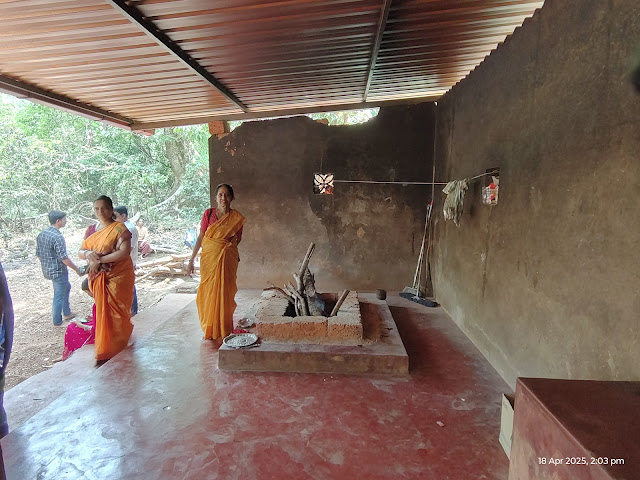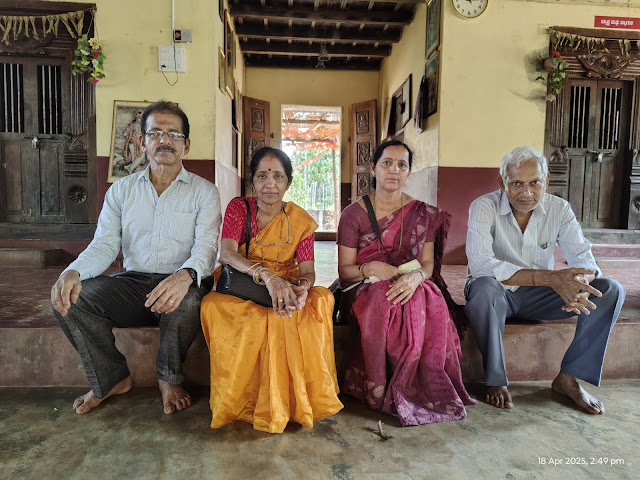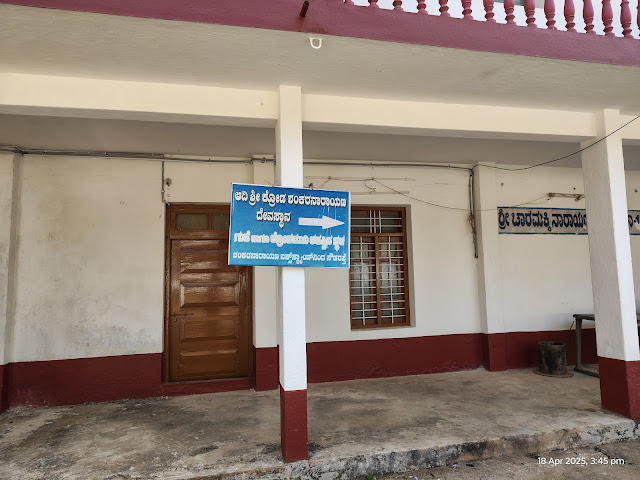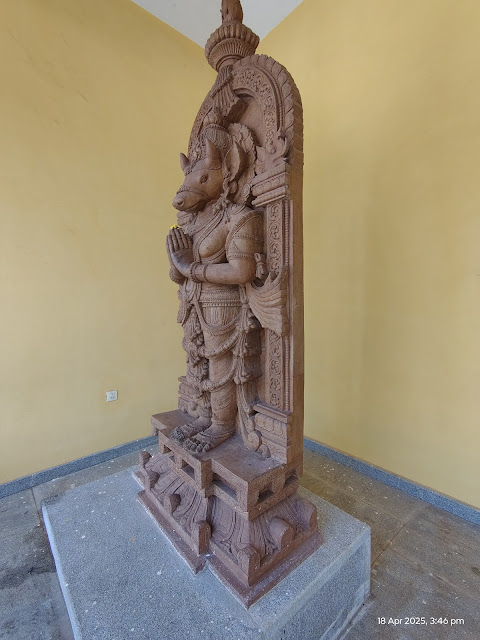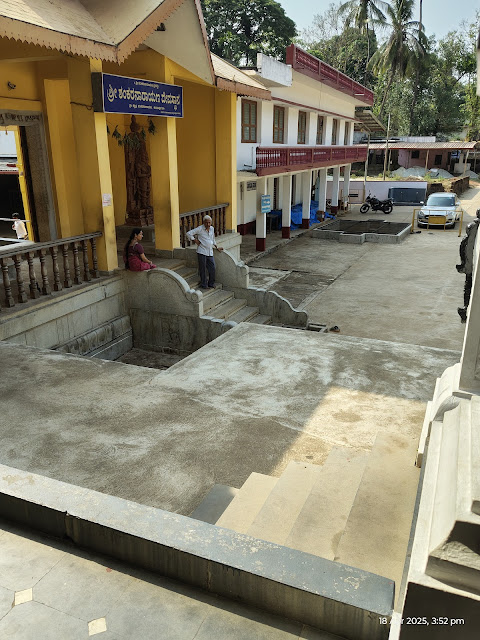Date of
Travel: 18th April (Good Friday)
Travelers:
Myself, Shreemathi, Gopi and family
Route:
Manipal – Kamalashile – Moodugallu – Shankaranarayana – Manipal
✨ A
Long-Pending Wish Fulfilled: Kamalashile Brahmi Durga Parameshwari Temple
I have
always cherished the desire to explore our region's sacred and historical
landmarks. While I had visited many temples and heritage sites over the years,
the Kamalashile Brahmi Durga Parameshwari Temple somehow remained
unchecked—despite several attempts. Plans were made, but something or the other
always came in the way.

Finally, on
the morning of 18th April, we received a phone call from Gopi, my
brother-in-law. He suggested that we visit the temple that day, as it was a Good
Friday holiday. With joy and enthusiasm, Shreemathi and I began preparing for
the journey. Gopi arrived at our Manipal residence at 10:30 AM, and we took off
through the scenic route:
Manipal –
Hebri – Kanbettu – Shedimane – Amavasebail – Siddhapura – Kamalashile.
Gopi's
knowledge of the terrain and the latest developments along the route enriched
our drive with interesting updates and insights.
We reached Kamalashile
at 12:00 PM. The heat was intense, but the spiritual energy of the temple was
overwhelming. We entered the temple and took a traditional round (pradakshina)
of the sanctum. The Managing Trustee Shri Sachidananda Chatra was overseeing
temple activities near the entrance.
I was delighted to learn that my late father-in-law,
Babayya Bhat (Ananthapadmnabha Bhat) of Goliyandadi, had a close relationship with Shri Chatra. Gopi
reminded me that Chatra would be happy to meet me.
Shri Chatra welcomed me warmly when I was introduced. His affectionate and friendly
nature left an indelible mark on my heart. Upon learning about our connection,
he personally arranged for prasadam, a shawl, and special annaprasadam for all
of us.
🛕 Temple
Experience & Hospitality
The temple
is remarkably well-maintained and managed with discipline and grace. Repeated
announcements about Annadana at Brahmi Hall reflected the systematic nature of
operations. Volunteers and staff treated every devotee with courtesy—there was no
rudeness, a refreshing contrast to the experiences in some crowded temples.
After the Mahapooje,
we offered prayers at the adjacent shrines of Lord Ganesh, Vishnu, and
Veerabhadra.
The annaprasadam was nothing short of a South Canara wedding feast—with
over 15 delicious items, including sweet pongal, payasam, curd,
and unlimited servings. We chose to sit cross-legged on the floor, although
seating arrangements were available.
I was
amazed by the scale and dedication with which the temple provides meals
year-round. It truly embodies the spirit of seva.
🕉️ Whispers
of Silence: A Visit to the Sacred Suparsha Cave, Kamalashile
After our
spiritual and fulfilling darshan at the Brahmi Durga Parameshwari Temple in
Kamalashile, our group—comprising Shreemathi, the Gopi family, and myself—set
out on a short yet soulful journey to a lesser-known gem: the Suparsha Cave. Although
modest in scale, this destination left a lasting impression on all of us
through its silence, serenity, and spiritual resonance.
📍 Location
& Background
Suparsha
Cave is located around 500 meters from the main Kamalashile temple complex. It
is easily accessible via a short forest trail that cuts through the lush
greenery of the Kundapura region in Udupi district, Karnataka.
According
to legend, this cave was discovered by King Suparshwa, a devout seeker who
chose this secluded spot for his intense penance in search of liberation (moksha).
Hence, the name Suparsha Cave is etched with ancient reverence and considered a
deep meditative energy site.
🌿 The
Journey Through Nature
The walk
from Kamalashile temple to the cave is serene and shaded, lined with towering
trees and chirping birds. As we moved forward, a hushed calm seemed to descend,
wrapping us in its embrace. It felt like we were slowly detaching from the
chaos of the outside world and entering a sanctuary carved out by nature.
Upon
reaching the entrance, the cave appeared humbly nestled into a rocky formation,
its modest size belying the powerful stillness within. Unlike touristy caves
that are lined with artificial lights and guides, Suparsha Cave remains raw and
untouched—a true spiritual retreat.
🪔 Inside the
Cave
The
interior of the cave is cool and dimly lit, with beams of sunlight filtering in
through cracks in the rock. We sat quietly for a while on the natural stone
floor, enveloped by the peace that only such ancient places can offer. The
sounds of the forest faded into the background, and all we could hear was our
breath, the occasional drip of water, and the echo of inner silence.
It is not a
place to rush through. Even though it has no grand idols or decorative
carvings, the cave is spiritually potent, making it ideal for meditation,
prayer, or simply quiet reflection.
💡 Practical
Information for Visitors
- Distance from Kamalashile Temple:
Approximately 500 meters (10–15 minutes walk)
- How to Reach: Walk from the temple premises;
no vehicle access is needed
- Footwear: Recommended to wear sturdy shoes
due to uneven terrain
- Time Required: 30 minutes to 1 hour
- Best Time to Visit: Early mornings or late
afternoons for cooler temperatures and better natural light
- No Entry Fee
🌼 Final
Reflections
Our visit
to Suparsha Cave was brief but deeply meaningful. It reminded us that not all
spiritual experiences require grandeur—some just need stillness, a quiet path,
and a mind willing to listen. After leaving the cave, we walked back to the
main temple in silence, each of us carrying a personal moment of peace etched
in our hearts.
For those
visiting Kamalashile, this hidden treasure is not to be missed. It is perfect
for those who seek solitude, inner stillness, and a connection with the divine
in its most natural form.
🌿 Mystic
Echoes from the Cave: A Journey to Moodugallu Sri Keshavanatheshwara
Temple, Keradi
Nestled deep in the heart of the Mookambika Reserve
Forest, away from the bustling cities and noisy pilgrim trails, lies a serene,
mystical, and awe-inspiring temple—Moodugallu Sri Keshavanatheshwara Temple
in Keradi. Our visit to this sacred cave temple wasn't just a journey—it
was an experience that touched our hearts and left us spellbound.
🚗 The Journey:
From Kamalashile to the Hidden Shrine
We began our journey from Kamalashile, unaware that what awaited us was not
just a destination, but a revelation. Saraswathi, Gopi's wife, was particularly
insistent on this trip. Having recently visited the temple, she was deeply
moved and wanted to share that divine experience with all of us.
What followed was a scenic yet challenging drive
through dense forest trails and rural roads that tested the skill of even the
most experienced drivers. The final stretch to Moodugallu is a narrow mud
road, winding through the hills, often with no guardrails or proper
boundaries. I vividly remember a rented car descending the slope at alarming
speed—its brakes had failed. In what could only be called divine
intervention, the driver managed to stop it inches away from our vehicle. The
man, shaken but safe, was immediately found praying to Lord Shiva, right there
on the car.
🕉️ Arrival at
the Temple: Walking Through Sacred Waters
The moment we reached the temple, all the tension and
fatigue melted away. A sense of calm embraced us. The Moodugallu Temple is a
cave temple, home to a self-manifested Shiva Linga. To reach the sanctum,
we had to walk through ankle-deep crystal-clear spring water—an
experience that was surreal and meditative.
The water, flowing perennially through the cave, is
home to fishes. The fishes swam around our feet curiously, and it is
said they often follow the devotees. While many pilgrims bring rice to feed
the fish, we, unfortunately, didn't know about this beautiful tradition. A
word to the wise—carry some rice with you. It's believed the fishes respond
joyfully and bring blessings in return.
🏞️ Moodugallu: Remote Yet Rich in Spirit
Moodugallu is not a village you casually pass by. Only
5–6 families reside here, relying entirely on solar power for
their basic needs, including agriculture. There is no electricity, and
mobile network is practically non-existent. It is a place untouched by urbanity
but full of purity.
Due to its inaccessibility, the temple remained
relatively unknown outside Keradi—until recently. After the film "Kantara",
which brought attention to coastal Karnataka's spiritual traditions and forests,
interest in such offbeat temples has seen a quiet rise. Still, Moodugallu
remains a hidden gem, unspoiled by commercial tourism.
🌑 A Festival Like No Other: Ellu Amavasya
The temple truly comes alive once a year, on "Ellu
Amavasya", when nearly 1,000–1,500 devotees gather to offer
prayers and perform rituals. A week before the event, the villagers of Keradi
voluntarily repair the roads, ensuring smooth access until the rains begin
again. During this season, any vehicle can comfortably reach the temple.
But the temple is quiet for the rest of the year, with
only the archaka (temple priest) and his family staying behind to
maintain its sanctity. They are humble, kind-hearted, and extremely helpful.
If you inform them a day in advance, they gladly prepare food and even
guide you through the area.
🪔 Final Thoughts: A Spiritual Sojourn Worth Taking
Moodugallu Sri Keshavanatheshwara Temple is not a
place to tick off a list—it is a destination that must be felt, experienced,
and remembered. Its raw natural beauty, the spiritual aura of the cave, the
ever-flowing spring, and the welcoming hearts of the local people come together
to create something magical.
If you're looking for a place where nature meets
divinity, silence speaks, and every step leads you inward, then
Moodugallu is waiting for you.
📝 Tips for Travelers:
- 🚗 Road
Condition: Only expert drivers or SUVs recommended; final 6 km is a
forest mud road.
- 🛕 Contact
in Advance: Inform the archaka if you need food arrangements.
- 🍚 Bring
Rice: For the fish inside the cave pond.
- 🕓 Best
Time to Visit: After road repairs (Ellu Amavasya) until early monsoon.
- ⚠️ No
Network: Be prepared for complete disconnection from the digital
world.
🌊 Shankaranarayana Temple – The Confluence of Divinities
Shankaranarayana is one of the seven sacred
places established by Maharshi Parashurama, known collectively as Parashurama
Kshetra. It is a unique and rare temple where one can witness the divine
confluence (sangam) of Shankara (Lord Shiva) and Narayana (Lord Vishnu)
in a single deity.
The temple is located in Shankaranarayana
village, nestled in the lush valleys near the Sahyadri mountain ranges, in Udupi
district, Karnataka, about 25 kilometers from the Arabian Sea. I have had the
privilege of visiting this spiritually significant temple.
The seven holy places of Parashurama Kshetra
include:
1.
Subrahmanya
2.
Udupi
3.
Kumbhakaashi
4.
Koteshwara
5.
Shankaranarayana
6.
Kolluru
7.
Gokarna
These are often compared to the seven sacred
sites of Rama Kshetra:
Ayodhya, Mathura, Maya, Kashi, Kanchi, Avanthika, and Puri.
Shankaranarayana is also referred to as Kroda,
named after Kroda Maharshi. According to the 24th chapter of Pushkara Kaanda in
the Padma Purana, there is a vivid account of Krodha Shankaranarayana. The
story narrates that the demons Kharasura and Rattasura were terrorizing the
people. Kroda Maharshi, in deep meditation, prayed to both Lord Shiva and Lord
Vishnu for deliverance. Pleased with his devotion, the Lords appeared in a
unified form as Lord Shankaranarayana and vanquished the demons.
The nearby hill, where Kroda Maharshi performed
his penance, is known as Kroda Giri. Atop this hill, idols of Lord
Shankaranarayana, along with Goddess Gowri and Goddess Lakshmi, are enshrined,
marking the spot of divine manifestation and meditation.
☕ Final Moments and Return Journey
After the last temple visit, we took the return route via
Neralakatte – Shankaranarayana – Goliyandadi – Shiroor Murkai – Neelavara –
Manipal.
We visited Shreemathi's house in Goliyandadi to meet
her mother, where we enjoyed a refreshing cup of coffee in warm company. On the
way back, we stopped at Kolalagiri roadside, where a local lady was selling
freshly harvested vegetables, cutting them right in the field beside her. We
bought some vegetables and returned home, reaching Manipal by 5 PM.
🙏 A Journey of Devotion, Bonding, and Joy
This trip perfectly blended devotion, nostalgia,
family bonding, and seamless planning. Special thanks to Saraswathi for
thoughtfully organizing every detail and Gopi for executing the plan
with such care and precision. Every temple we visited, every stop we made, and
every moment we shared felt divine.
As we returned home, we were warmly welcomed by Thimon,
🐶our affectionate dog, who seemed
visibly emotional. He had spent the entire day in silence, missing our
presence, and as if to express his feelings, he whimpered gently, as though
saying, "Not a single soul was here to talk to me today."









